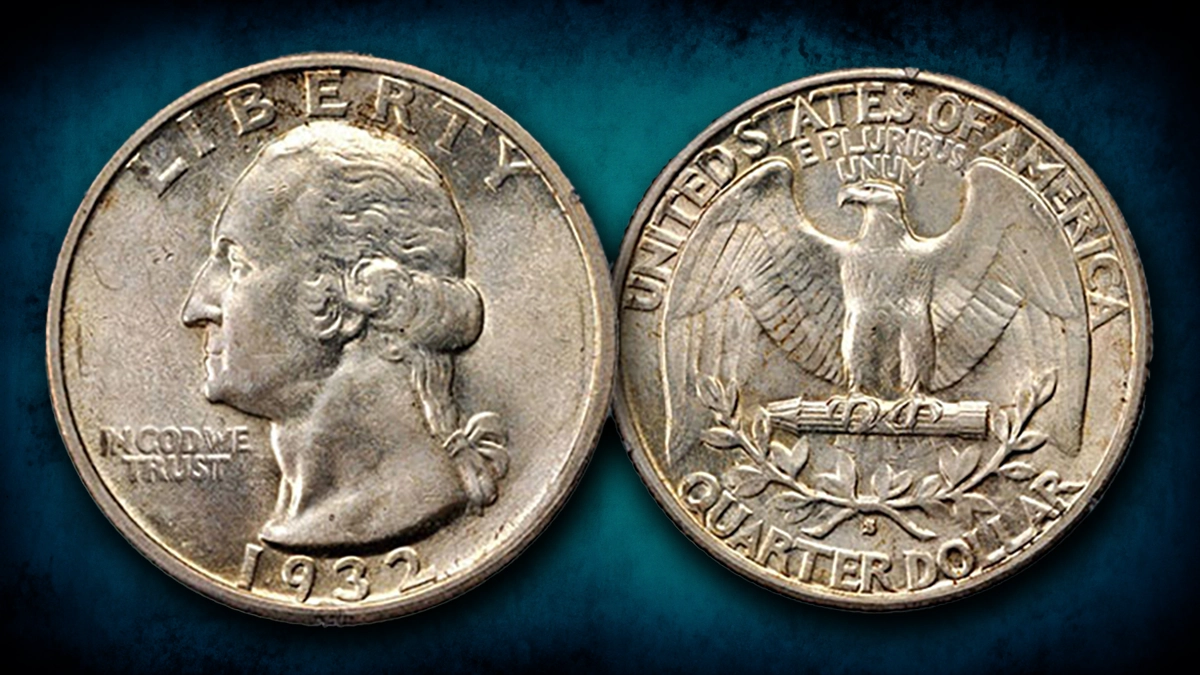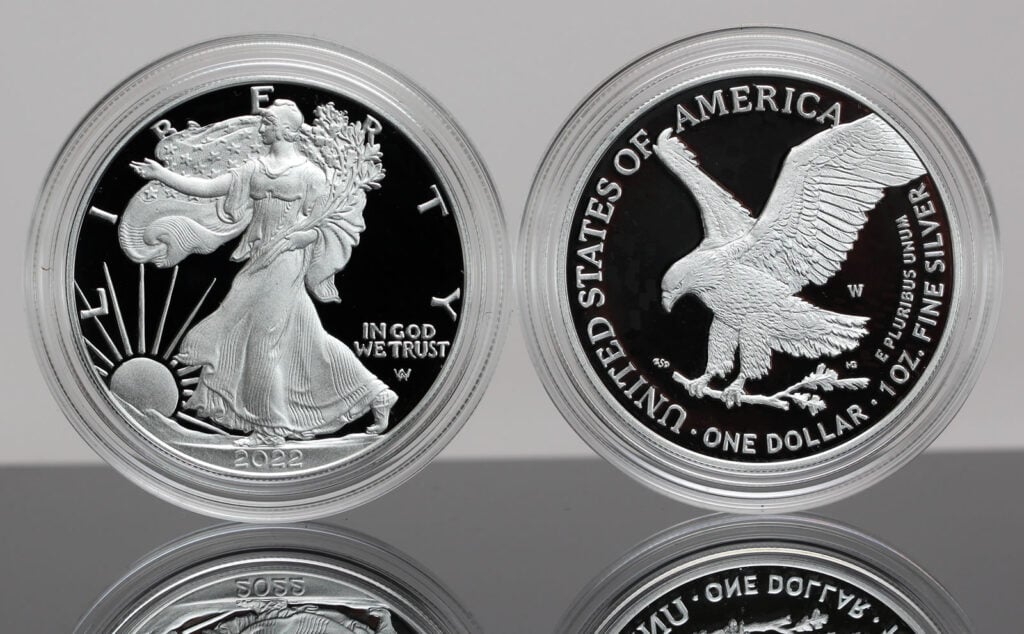
By Charles Morgan and Hubert Walker for CoinWeek Notes …..
As the bicentennial of George Washington’s birth in 1932 drew closer, the United States Mint began preparing the Nation’s numismatic arena. With the Act of March 4, 1931, the U.S. Senate decreed that the portrait of Washington “shall appear on the obverse, with appropriate devices on the reverse” (U.S. Mint Report, 1932, pg. 134).
Production started in early 1932 in Philadelphia, Denver, and San Francisco. Despite whatever grand ambitions the Mint may have had for the launch of the Washington quarter, the Great Depression was raging. The Depression, being the worst economic disaster that has ever hit the U.S. economy, decreased demand for coinage by over 90%. No half dollars or silver dollars were struck from 1931 to 1933, and if 1932 had not been the 200th anniversary of Washington’s birthday, no quarters would have been struck in any of those years, either. But they were struck in 1932. Additionally, many pieces were stored in the Treasury Department’s vaults.
Adjusting, the Mint struck a combined total of 6,248,800 pieces at all three mints despite no real demand for the coin. While the Philadelphia facility is responsible for the bulk of production, the mint in San Francisco struck only 408,000 pieces. This extraordinarily low mintage makes the 1932-S the lowest mintage of the entire series (with a mintage of 436,800, the 1932-D is a close second). These two circulation strike issuances are the only ones in the whole series with a mintage of fewer than one million pieces, and both are considered among the most significant and scarcest quarters of the 20th century.
What Is the 1932-S Washington Quarter Worth?
True low-grade examples are almost as rare as high-grade specimens, and when certified pieces from P1 to G4 can be found, they are generally sold for between $50 to $80.
Mid-grade examples from VF to XF can be found at most reputable dealers for between $100 to $200.
Coins surviving in low Mint State (MS60 to 62) have a similar value and sell for $300 to $400.
Prices increase significantly in higher Mint State grades (MS64 to 66). Examples in these high grades can sell for as little as $800 or as much as $5,000. Truly Gem examples in MS66 sell for much higher prices. The auction record is held by a piece graded MS66 with a green CAC verification sticker that sold in a David Lawrence Rare Coins (DLRC) March 2020 auction for $45,500.
* * *
Market Data and Noteworthy Specimens –
In an advertisement published in the July 1964 issue of Numismatic Scrapbook Magazine, Oklahoma dealer Roy L. Baker offered a Brilliant Uncirculated 1932-S quarter dollar for $70. Prices have risen significantly since then.
Charles Morgan’s August 2025 Market Update
PCGS estimates that the 1932-S Washington Quarter mintage has a survival rate of approximately 10%, with roughly 40,000 pieces estimated to exist in all grades. Despite being struck during the Great Depression, the new design was received as a collector’s item, and the general public and numismatic community saved many pieces. This has resulted in a lopsided distribution of surviving examples, with nearly 30% of the remaining coins thought to grade MS60 or better.
Due to high demand, Gem examples (MS65 or better) are quite costly for collectors to obtain. While the 1932-S has a smaller mintage than the 1932-D, it is slightly more common in Gem Mint State. Through August 2025, PCGS has certified 276 examples of the 1932-S and 115 examples of the 1932-D in MS65 to MS66.
There are no certified examples in higher grades.
NGC has graded 122 examples of the 1932-S quarters in Gem condition through the same period, and only 24 examples of the 1932-D.
Top Population: PCGS MS66 (10, 8/2025), NGC MS66 (10, 8/2025), and CAC MS66 (3:1 stickered:graded, 8/2025).
- NGC MS66 #6099842-002: Heritage Auctions, October 7, 2021, Lot 3504 – $15,600; Stack’s Bowers, April 5, 2022, Lot 3036 – $22,800. Champagne toning with a hint of purple on the reverse.
- PCGS MS66 #42108715: Heritage Auctions, December 16, 2021, Lot 3322 – $34,800. Rim toning on the reverse, crescent rim toning on the left side of the obverse.
- PCGS MS66 #38265447: “The Washington Rainbows Collection, the #1 PCGS Registry Set of Silver Washington Quarters, 1932-1964”, Stack’s Bowers, March 25, 2021, Lot 2276 – $38,400. Washington Rainbows on insert. Brilliant obverse, hit on cheek and nose. G in GOD is weak. Reverse lightly toned.
- PCGS MS66 #38559950: Heritage Auctions, March 2004, Lot 5752; “The D. Brent Pogue Collection, Part VII,” Stack’s Bowers, March 20, 2020, Lot 7183 – $43,200. Superb luster, purple, gold, and green toning on the obverse.
- NGC MS66 #4882536-005: Heritage Auctions, July 11, 2019, Lot 3054 – $13,220.40.
- NGC MS66 #4834067-001: As NGC MS66 #2080710-001. Heritage Auctions, July 31, 2008, Lot 1655 – $10,925; Stack’s Bowers, February 2014, Lot 1189, $15,275. As NGC MS66 #4834067-001. Heritage Auctions, June 6, 2019, Lot 3089 – $13,200. Dark rainbow rim toning on the obverse and reverse. Bright spot under bow.
- PCGS MS66 #44604488: As NGC MS66. Stack’s Bowers, June 2014, Lot 1401 – $15,275. Pea green toning at the bust truncation and the date. Purple toning over face and date.
- PCGS MS66 CAC #16537838: Heritage Auctions, January 10, 2013, Lot 5606 – $35,250. Lightly toned.
- PCGS MS66 #2403679: Heritage Auctions, August 9, 2001, Lot 6049 – $18,400. Old Green Holder.
- NGC MS66 CAC #247199-001: Heritage Auctions, February 14, 2008, Lot 505 – $20,700. Brown and gold iridescent toning.
* * *
Design
Obverse:
Designed by John Flanagan, the obverse of the 1932-S Washington quarter is based on a bust of the general created by the neoclassical French sculptor Jean-Antoine Houdon in 1785. However, Flanagan’s design differs from the original bust in several ways, such as a slightly different head shape and several curls of hair that are not on the bust; for comparison, the bust can be viewed at the late president’s Virginia estate, Mount Vernon. Under the left-facing bust’s chin is the motto IN GOD WE TRUST. The legend LIBERTY runs along the top of the coin’s field, and the date 1932 is below. In small letters, Flanagan’s initials “JF” can be found above the “2” in 1932 at the base of the bust.
Reverse:
Unlike the obverse, no restrictions were placed on the candidate sculptors when designing the Washington quarter reverse. Flanagan’s reverse is dominated by a heraldic eagle with outstretched wings and a left-facing head. The eagle is perched on a neat bundle of arrows with two intertwined olive branches below and the “S” mintmark centered between the two olive branch stems. The two main inscriptions above the eagle are UNITED STATES OF AMERICA and E PLURIBUS UNUM. Finally, at six o’clock on the design is the denomination written out as QUARTER DOLLAR.
Edge:
The edge of the 1932-S Washington quarter is reeded.
Designer
John Flanagan was born in New Jersey in 1865 and lived in New York for most of his life. He began working with Augustus Saint-Gaudens in 1884 at the age of 20 and quickly became a well-known sculptor and medallic artist in his own right. Saint-Gaudens made introductions for Flanagan at the United States Mint. While the Washington quarter was his sole numismatic design, Flanagan designed numerous famous medals and sculptures, including the official medal of the 1915 Panama-Pacific International Exposition, the official Verdun medal gifted to France by the United States Government, and the 1924 bust of Saint-Gaudens. Flanagan was also a member of the American Numismatic Society (ANS).
Coin Specifications
| Country: | United States of America |
| Year Of Issue: | 1932 |
| Denomination: | Quarter Dollar (25 Cents USD) |
| Mint Mark: | S (San Francisco) |
| Mintage: | 408,000 |
| Alloy: | 90% Silver, 10% Copper |
| Weight: | 6.25 g |
| Diameter: | 24.30 mm |
| Edge: | Reeded |
| OBV Designer: | John Flanagan |
| REV Designer: | John Flanagan |
| Quality: | Business Strike |
* * *
The post 1932-S Washington Quarter : A Collector’s Guide appeared first on CoinWeek: Rare Coin, Currency, and Bullion News for Collectors.



